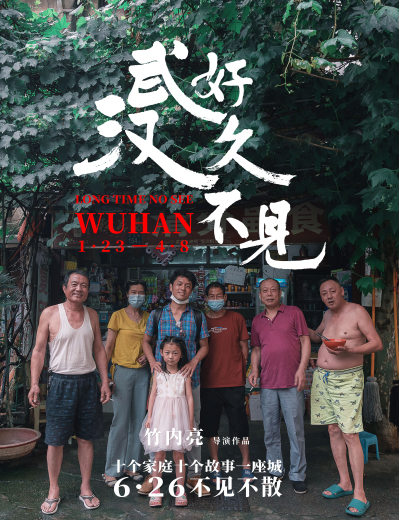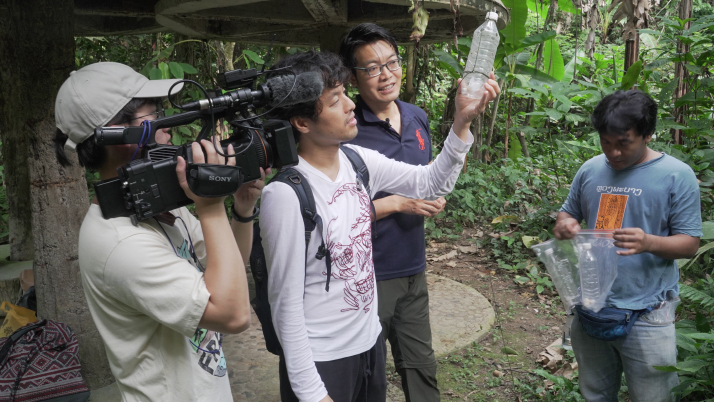| Lifestyle |
| Documentary maker Ryo Takeuchi wants to share China's story with the rest of the world | |
|
|
 A poster for Long Time No See, Wuhan, Ryo Takeuchi's 2020 documentary (COURTESY PHOTO)
For Ryo Takeuchi, the year 2020 means incredible achievement. It was the year he made two documentaries on China's response to the novel coronavirus disease (COVID-19), which attracted numerous viewers, trended as hashtags on social media platforms, and were watched even by people with no interest in documentaries. The first documentary, Emergent Report: A City Sees No More New Confirmed Cases, probably owes its existence to the decision he took in 2012 to relocate to Nanjing in Jiangsu Province, east China. His wife Zhao Ping is from Nanjing and the city attracted him for its vitality and yet unhurried pace of life. He also wanted to make a documentary series on the Japanese in China and the Chinese in Japan. In February 2020, Takeuchi and his family were asked to quarantine at home after they returned to Nanjing from Japan. Initially, he did not understand the COVID-19 prevention and control measures and thought they were an overreaction. But thanks to the stringent approach, the city of over 8.5 million people saw only 93 COVID-19 cases. A month later, all patients recovered, and his documentary on the government's swift and efficient response and people's solidarity in the face of the epidemic was released. By that time, the virus had started spreading in Japan. The Japanese media covered the documentary and it caught people's attention in Japan and farther. It was dubbed into various languages, and television stations in over 10 countries, including Russia, the Republic of Korea and Italy, contacted Takeuchi for broadcasting it. "I am a documentary maker. My job is to record China and share it with others," Takeuchi told Beijing Review.  Ryo Takeuchi visits Xishuangbanna Dai Autonomous Prefecture in Yunnan Province, southwest China (COURTESY PHOTO)
The real China On July 1, 2020, Takeuchi arrived in Wuhan, the city in central China where the first COVID-19 cases were reported in the country. He spent 10 days there recording the lives of 10 people after the city ended its 76-day lockdown on early April 8. One of them is Lai Yun, who owns a Japanese restaurant. Lai had gone to the seafood market where multiple infections were first found. His restaurant remained closed for 133 days due to the epidemic. His experiences were a window into how the residents of Wuhan felt about the epidemic and their hopes for the future. The new 1-hour documentary, Long Time No See, Wuhan, shows how Wuhan is back on track through the busy traffic on the streets, a bustling midnight market and other details. Released on July 26, it has been watched over 40 million times on the Internet. "Nanjing's policy in fighting the epidemic is worth sharing, and so is Wuhan's current situation," the director said. The worries he and his colleague had about visiting Wuhan were dispelled after seeing the city with their own eyes. It felt that nothing untoward had happened except there weren't many people, he said in the documentary. He has refused financial support to make the documentaries because he thinks a good one has to remain neutral, calm and rational, not influenced by anyone. Next, he turned his attention to the Chinese Government and people's efforts to revive the economy. In 2020, China was the only major country to achieve positive GDP growth, with its economy expanding by 2.3 percent. "How is China achieving pandemic prevention and control while reviving its economy simultaneously?" he asks at the beginning of China's Post-Pandemic Era, his latest documentary released in January. To find the answer, he visited several cities in east China. He found Suzhou in Jiangsu was using hi-tech to combat COVID-19, using self-driving buses and unmanned delivery vehicles and sweepers. His documentary also shows how a village in Yiwu, the city in Zhejiang Province, with the largest wholesale market, has become famous for live-streaming e-commerce, highlighting Internet power and the development of new business modes due to COVID-19. In winter, there was a spike in COVID-19 cases once again due to the cold weather. By January 13 this year, Japan had a cumulative total of 300,000 cases. On one single day, there were 97 deaths, a record, The Japan Times reported. "I watched the news on Japan every day, indicating it was under great pressure to contain the virus," Takeuchi said. "China has achieved remarkable results in this regard, so I wanted to share some of its experience with Japanese viewers." An open mind At the end of China's Post-Pandemic Era, Takeuchi tells viewers, "I know you will not look at China with prejudice." This is his objective—persuading more and more Japanese to overcome their prejudice against a neighboring country that is different from what they imagine it to be. While the Chinese are interested in Japanese culture, animation and fashion, the Japanese lack an understanding of China. In November 2020, the Genron NPO, a Japanese non-profit think tank, and China International Publishing Group jointly released the Japan-China Public Opinion Poll results, the 16th edition of the annual survey. It found an overall increase in Chinese expectations for improved cooperation with Japan. But Japanese impressions of China and Japanese public opinion on the bilateral relationship had deteriorated. Takeuchi, who had worked for the Japanese media for many years, thinks it is not an issue of whether the Japanese like China but whether they know about China. With limited news sources, television is their primary channel of information. The traditional Japanese media, including TV stations, tend to focus more on negative reports to attract people's attention. This makes it difficult for Japanese viewers to warm to China. Chinese Foreign Ministry spokesperson Hua Chunying, who watched the documentary at a press conference, said the world needs to know the real situation in China. "We commend director Takeuchi for objectively and truthfully recording this extraordinary journey China has traversed," she said, urging more journalists to see, write, film and document not only with their eyes and equipment but also with their heart. "It is hard to break the traditional media's bias against China, but new media works differently. They observe China with an objective attitude and influence more young users," Takeuchi said. For instance, a significant number of young Japanese have developed an interest in China. They study popular Chinese-style makeup on Xiaohongshu, an Instagram-like Chinese fashion and lifestyle-sharing platform, and are fans of Chinese video games. His new project is to film the Yangtze River. He had taken part in a documentary on the river in 2011, when he worked for Japanese broadcaster NHK, and wants to return to the river as it is "a good subject to present China in terms of its economy and culture." He wants to tell the world about China's poverty alleviation achievement in its western region and also cover its environmental protection efforts. "Ten years have passed since the last documentation of the river [by us], so it is a good time to show how China has changed over the decade through exploring the Yangtze," he said. (Print Edition Title: The Japanese Recorder) Copyedited by Sudeshna Sarkar Comments to dingying@bjreview.com |
|
||||||||||||||||||||||||||||||
|
